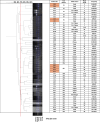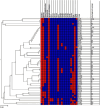Characterization of non-O157 enterohemorrhagic Escherichia coli isolated from different sources in Egypt
- PMID: 39574016
- PMCID: PMC11580514
- DOI: 10.1186/s12866-024-03636-3
Characterization of non-O157 enterohemorrhagic Escherichia coli isolated from different sources in Egypt
Abstract
Background: Enterohemorrhagic Escherichia coli (EHEC) O157 is implicated in serious food and water-borne diseases as hemorrhagic colitis (HC), and the potentially fatal hemolytic uremic syndrome (HUS). However, new players of non-O157 EHEC have been implicated in serious infections worldwide. This work aims at analyzing serotype and genotypic-based virulence profile of EHEC local isolates.
Methods: A total of 335 samples were collected from different sources in Egypt. E. coli was isolated and subjected to serotyping. Non-O157 EHEC isolates were tested for virulence genes using PCR, phenotypic examination, phylogenetic typing, and molecular investigation by ERIC typing and MLST to disclose genetic relatedness of isolates. A heat map was used to identify potential associations between the origin of the isolates, their phenotypic and genotypic characteristics.
Results: A total of 105 out of 335 isolates were identified as E. coli. Surprisingly, 49.5% of these isolates were EHEC, where O111, O91, O26 and O55 were the most prevalent serotypes including 38.46% from stool, 21.15% urine, 23.1% cheese, 9.62% meat products, 3.85% from both yogurt and sewage water. Screening 15 different virulence genes revealed that sheA, stx2 and eae were the most prevalent with abundance rates of 85%, 75% and 36%, respectively. Fifteen profiles of virulence gene association were identified, where the most abundant one was stx2/sheA (19%) followed by stx2/stx2g/sheA/eae (11.5%). Both stx2/sheA/eae and stx2/stx2g/sheA were equally distributed in 9.6% of total isolates. Phylogenetic typing revealed that pathogenic phylogroups B2 and D were detected among clinical isolates only. Forty-six different patterns were detected by ERIC genotyping. MLST resolved three sequence types of ST70, ST120 and ST394. The heat map showed that 21 isolates were of 70% similarity, 9 groups were of 100% clonality.
Conclusions: The prevalence of non-O157 EHEC pathotype was marginally higher among the food isolates compared to the clinical ones. The endemic ST120 was detected in cheese, necessitating crucial measures to prevent the spread of this clone. Clinical EHEC isolates exhibited a higher score, and combination of virulence genes compared to food and sewage water isolates, thereby posing a significant public health concern.
Keywords: Biofilm; Intimin; Non O157 EHEC- ERIC; Serum resistance; Shiga toxin.
© 2024. The Author(s).
Conflict of interest statement
Declarations. Ethics approval and consent to participate: The study was approved by Research Ethics Committee of Faculty of Pharmacy, Mansoura University, Egypt (Code:2022–126). All procedures performed in the study involving human participants were in accordance with the 1964 Helsinki declaration and its later amendments. Informed consent was obtained from all individual participants included in the study. Consent for publication: Not applicable. Competing interests: The authors declare no competing interests.
Figures


Similar articles
-
Enterohemorrhagic Escherichia coli as causes of hemolytic uremic syndrome in the Czech Republic.PLoS One. 2013 Sep 6;8(9):e73927. doi: 10.1371/journal.pone.0073927. eCollection 2013. PLoS One. 2013. PMID: 24040117 Free PMC article.
-
Influence of Season and Feedlot Location on Prevalence and Virulence Factors of Seven Serogroups of Escherichia coli in Feces of Western-Canadian Slaughter Cattle.PLoS One. 2016 Aug 2;11(8):e0159866. doi: 10.1371/journal.pone.0159866. eCollection 2016. PLoS One. 2016. PMID: 27482711 Free PMC article.
-
[Enterohemorrhagic Escherichia coli as the cause of diarrhea in the Czech Republic, 1965-2013].Epidemiol Mikrobiol Imunol. 2014 Sep;63(3):173-83. Epidemiol Mikrobiol Imunol. 2014. PMID: 25412480 Czech.
-
Enterohaemorrhagic Escherichia coli O26:H11/H-: a human pathogen in emergence.Berl Munch Tierarztl Wochenschr. 2007 Jul-Aug;120(7-8):279-87. Berl Munch Tierarztl Wochenschr. 2007. PMID: 17715820 Review.
-
Phytochemicals Controlling Enterohemorrhagic Escherichia coli (EHEC) Virulence-Current Knowledge of Their Mechanisms of Action.Int J Mol Sci. 2025 Jan 4;26(1):381. doi: 10.3390/ijms26010381. Int J Mol Sci. 2025. PMID: 39796236 Free PMC article. Review.
Cited by
-
In Silico Design of a Multiepitope Vaccine Against Intestinal Pathogenic Escherichia coli Based on the 2011 German O104:H4 Outbreak Strain Using Reverse Vaccinology and an Immunoinformatic Approach.Diseases. 2025 Aug 13;13(8):259. doi: 10.3390/diseases13080259. Diseases. 2025. PMID: 40863232 Free PMC article.
-
Enteroaggregative Escherichia coli foodborne outbreak in Shandong Province, China (2023): comprehensive epidemiology and genomic resistance profiling.Front Microbiol. 2025 Jun 27;16:1577277. doi: 10.3389/fmicb.2025.1577277. eCollection 2025. Front Microbiol. 2025. PMID: 40657497 Free PMC article.
References
-
- Dale AP, Woodford N. Extra-intestinal pathogenic Escherichia coli (ExPEC): disease, carriage and clones. J Infect. 2015;71(6):615–26. - PubMed
-
- Jang J, Hur HG, Sadowsky MJ, Byappanahalli M, Yan T, Ishii S. Environmental Escherichia coli: ecology and public health implications—a review. J Appl Microbiol. 2017;123(3):570–81. - PubMed
MeSH terms
Substances
LinkOut - more resources
Full Text Sources
Medical

